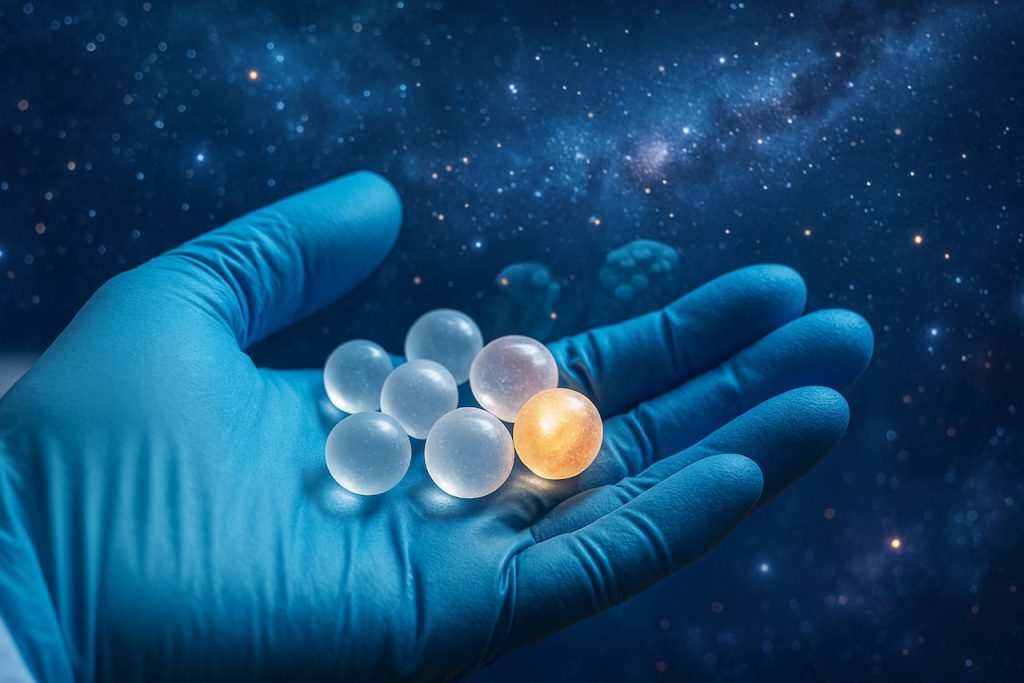Submission 2025
| Submitted by: | Pulkit Kumar |
| Department: | Surgery |
| Faculty: | Medicine |
This image captures a quiet revolution—a glimpse into the future of care for those living with Type 1 Diabetes. Nestled in the gloved hand of a researcher are biodegradable spheres—microparticles smaller than a grain of sand, yet filled with extraordinary potential. Though magnified here, their true size is nearly invisible—an artistic choice to reflect their outsized impact. Each glowing particle holds a miniature universe: a metaphor for the global change they promise. The cosmic backdrop echoes this vision—small innovations, big ripple.
These drug-eluting carriers are guardians. Co-transplanted with insulin-producing islets, they release immunomodulatory agents precisely where needed, shielding grafts from immune destruction—without systemic side effects like cancer risk.
Systemic immunosuppression carries adverse risks. For many, hope remains distant. But this approach opens a new frontier—only one donor per patient, balanced immunity, and grafts given a true chance to thrive. This image is an ode to possibility: the promise of science to not only heal, but to reimagine what’s possible when precision meets purpose.
Was your image created using Generative AI?
Yes.
Did you upload any materials into an AI tool to help generate your image?
No.
Which model of generative AI did you use?
Canva AI.
How was your image created?
This image was digitally generated to visually represent the core concept of my research on biodegradable, drug-eluting microparticles for islet transplantation in Type 1 Diabetes. I used a generative image model to create a hyperrealistic scene of a gloved researcher’s hand holding glowing microparticles. The particles were intentionally enlarged to highlight their symbolic weight, while their glow and the cosmic background visually reflect their global potential and transformative impact. The visual metaphor was based on lab work at the Alberta Diabetes Institute and Clinical Islet Transplantation Laboratory, where these particles are being developed and tested. The design choices were made to emphasize scale, delicacy, and impact—showing how something nearly invisible to the eye can influence healthcare on a planetary scale.
How did you craft your prompt to guide the generative AI in creating your image? Please describe the technique or approach you used to convey your vision to the AI.
My goal was to create a minimalistic yet powerful visual that symbolized the potential of localized drug delivery in Type 1 Diabetes treatment. I crafted the prompt to depict a gloved researcher’s hand gently holding glowing microparticles—intentionally enlarged to reflect their scientific and global impact. To evoke universality and precision, I added stylistic instructions for a cosmic background, soft lighting, and a hyperrealistic aesthetic. I iterated by refining keywords such as “biodegradable spheres,” “gentle grasp,” “microscopic but glowing,” and “cosmic texture,” while using aspect ratio and detail settings to enhance visual clarity and symbolism. I avoided text or clutter, emphasizing a clean composition to reflect both scientific precision and visionary healthcare transformation.
Please describe what you uploaded to the AI tool, and confirm that the material is your original work, licensed for use (e.g., Creative Commons), used with proper permission.
I did not upload any third party or external content to the AI tool. The image was generated entirely through prompt-based inputs informed by my original research at the Alberta Diabetes Institute and the Clinical Islet Transplantation Laboratory, University of Alberta. The concept, scientific details, and visual narrative were all derived from my own work on biodegradable microparticles for localized drug delivery in islet transplantation. No identifiable people, copyrighted visuals, or external images were used. The final image reflects a fully original, ethically guided visual interpretation of my research and is compliant with institutional standards and copyright guidelines.
Where is the image located?
Conceptual visualization inspired by research conducted at the Alberta Diabetes Institute and Clinical Islet Transplantation Laboratory, University of Alberta. The image draws from ongoing biomaterial and transplantation research focused on localized drug delivery systems for Type 1 Diabetes treatment.

